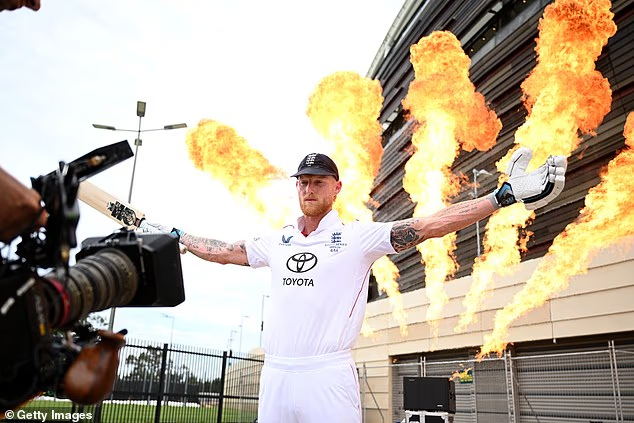A total of 445 cricketers have played an Ashes Test for England against Australia, going all the way back to the first official series under that name in 1882-83.
While Australia hold only a minor edge in series victories – 34 to 32, with seven draws – they have held the urn for almost three decades longer than England, 84 years to 55.
Ben Stokes leads the latest generation Down Under, desperate to regain the urn over the next two months for the first time since it disappeared back into enemy hands in 2017-18.
The 16-man squad that Stokes leads will each hope to crack this list of England’s greatest Ashes players one day, but who for now are the top 25? Here, Wisden Editor and Daily Mail Sport cricket correspondent LAWRENCE BOOTH ranks them from 25 to 1.
And there are a few surprising omissions…
(all stats only from official Ashes Tests, thus excluding 1877 and 1980 series).
Ben Stokes is ready to lead England Down Under in the 74th Ashes series, with his side looking to win the urn back for the first time since 2017-18

How many of England’s 16-man squad will end up on this list in future years?

25. Derek Underwood
25 Ashes Tests, 1968-77. Key Ashes stats: 88 wickets at 26.26, four five-fors.
‘Deadly’ Derek’s Ashes highlight came early in his career: seven for 50 at the Oval to square the 1968 series at the last gasp, after spectators had helped mop up the outfield following a downpour.
But there were other performances of which most players could only have dreamt: 10 wickets on a fungus-infected Headingley pitch that prompted dark mutterings from Australia in 1972; 11 at batsman-friendly Adelaide during England’s ill-fated 1974-75 tour; a match-winning six-for at Old Trafford in 1977.
If there was any help to be found from the surface, Underwood’s brisk left-arm spin would invariably find it.

25. Derek Underwood: If there was any help to be found from the surface, Underwood’s brisk left-arm spin would invariably find it
24. Michael Vaughan
10 Tests, 2002-05. Key stats: 959 runs at 47.95, four centuries.
Between Mike Brearley and Stokes, the best man-manager among England captains was Vaughan.
When Australia wildly celebrated a nail-biting draw in the third Test at Old Trafford in 2005 – in which Vaughan hit a first-innings 166, the first century of the series – he made sure his team soaked up the significance of the moment: an all-time great Aussie team, he pointed out, were delirious over a draw, and there for the taking.
A few weeks later, it was Vaughan’s England who were celebrating.
Don’t forget, either, his runs during a losing cause in 2002-03: three superb centuries in a tally of 633, against a masterful attack in home conditions.

24. Michael Vaughan: Between Mike Brearley and Stokes, the best man-manager among England captains was Vaughan
23. Bob Willis
31 Tests, 1971-83. Key stats: 128 wickets at 26.14, seven five-fors.
Willis did far more than bowl like a demon one afternoon in Leeds, but it’s fair to say his eight-for-43 destruction of Australia in 1981 sits at the top of his CV.
Written off by the press and troubled by wonky knees, he appeared in a trance as he ran through Kim Hughes’s team, prompting Richie Benaud to observe: ‘It was almost as if he was in another world.’
Wisden was equally impressed: ‘Willis bowled as if inspired. It is not uncommon to see him perform for England as if his very life depended on it, but this was something unique.’
Willis took six other hauls of five or more against Australia, but Headingley ’81 was his crowning glory.
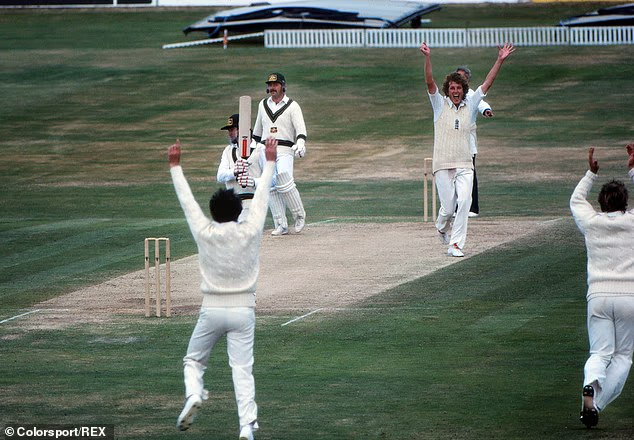
23. Bob Willis: Willis did far more than bowl like a demon one afternoon in Leeds, but it’s fair to say his eight-for-43 destruction of Australia in 1981 sits at the top of his CV
22. Douglas Jardine
10 Tests, 1928-33. Key stats: 540 runs at 31.76.
You didn’t think we’d leave him out, did you?
The brains behind the Bodyline tactics designed to neuter Sir Donald Bradman in 1932-33, Jardine might have been an assassin in another life, possessing nous and determination in equal measure, plus a fanatical hatred of Australians.
‘They don’t seem to like you much, Mr Jardine,’ said team-mate Patsy Hendren during the 1928-29 tour. Jardine replied: ‘It’s f***ing mutual.’ He nurtured his antipathy for the next four years, and when he was named captain for ’32-33, Pelham Warner quipped: ‘Well, we may well win the Ashes, but we may lose a Dominion.’
Down Under, he unleashed Harold Larwood and leg theory (and a Harlequin cap while batting, which riled the locals), and damn the consequences. England won 4–1, and Bradman averaged a mere-mortal 56. It remains the most ruthless victory in Test cricket.
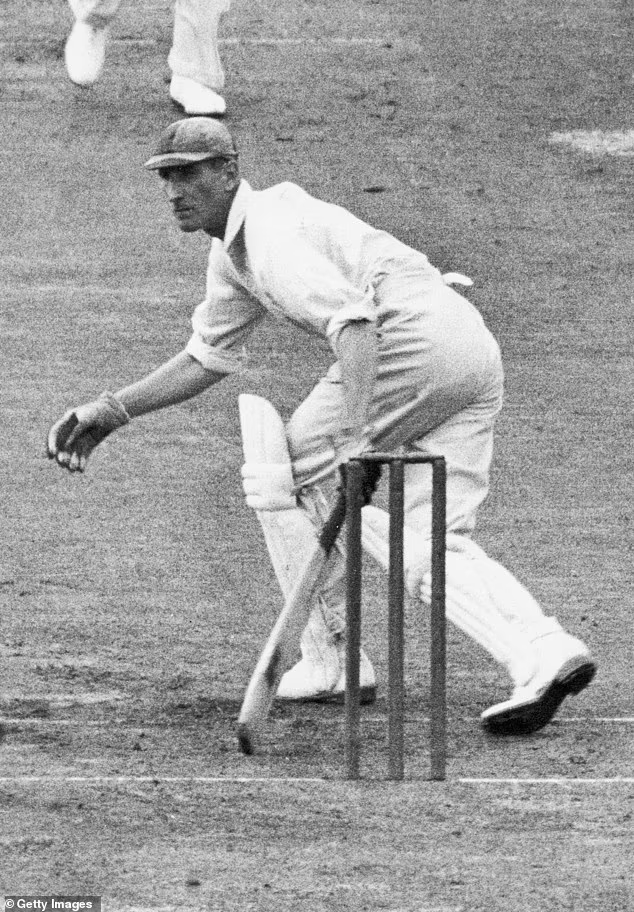
22. Douglas Jardine: The brains behind the Bodyline tactics designed to neuter Bradman in 1932-33, Jardine might have been an assassin in another life
21. John Snow
20 Tests, 1968-75. Key stats: 83 wickets at 25.61, four five-fors.
Just as England’s 2–0 win Down Under in 1970-71 remains one of the most underrated of all their triumphs, so Snow never quite gets the credit he deserves for his ferocious fast bowling.
He took 31 wickets at 22 on that trip, despite the Australian umpires’ refusal to grant England a single lbw decision in six Tests, while his seven for 40 to win the fourth at Sydney have not since been bettered by England Down Under.
When the teams returned to the SCG for the series finale, Snow was warned by umpire Lou Rowan for bouncing Australian tailender Terry Jenner, then grabbed by a drunken spectator on the boundary.
Ray Illingworth led his team off the field in protest, before returning to win back the Ashes. Snow, a published poet, loved the drama.
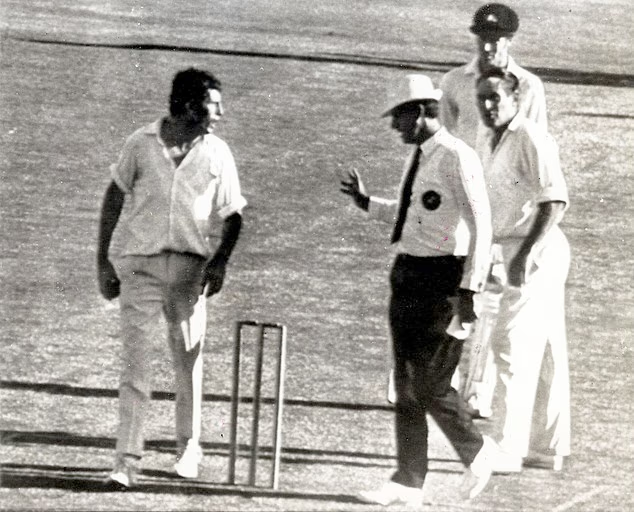
21. John Snow: In the 1970-71 series finale, Snow was warned by umpire Lou Rowan for bouncing Australian tailender Terry Jenner
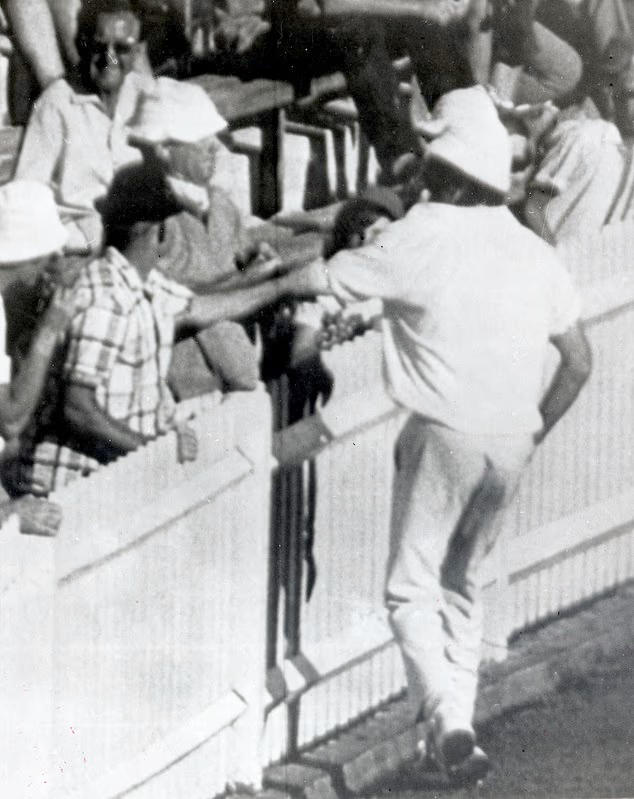
Snow was then grabbed by a drunken spectator on the boundary, and England captain Ray Illingworth led his team off the field in protest
20. Ben Stokes
24 Tests, 2013-23. Key stats: 1,562 runs at 36.32, 41 wickets at 38.95, four centuries, two five-fors.
Stokes makes the list not because his overall stats are especially eye-catching, but because his peaks are towering – and because he is capable of scaring Australia.
His piece de resistance was, and may always be, his unbeaten 135 at Headingley in 2019. But there’s also his century on a cracked WACA pitch on his first Ashes tour in 2013-14, an easily forgotten hundred to give England a sniff at Lord’s in 2019, and his almighty 155 at the same venue, including nine sixes, four years later.
We haven’t even mentioned a pair of six-fors, at Sydney and Trent Bridge. Stokes frightens Australia, whether or not they care to admit it.
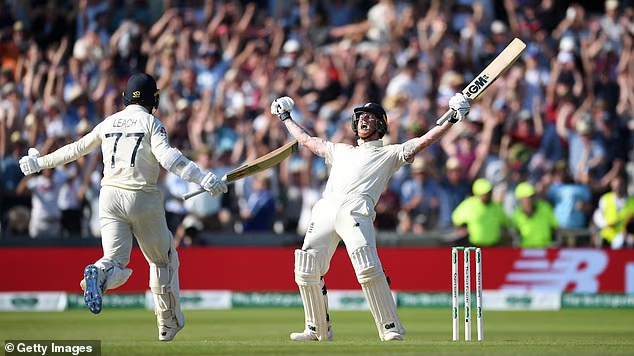
20. Ben Stokes: This man frightens Australia, whether or not they care to admit it
19. Andrew Flintoff
14 Tests, 2005-09. Key stats: 856 runs at 34.24, 43 wickets at 36.11, one century, two five-fors.
Some may wonder why the man who in 2006-07 captained England to their first Ashes whitewash for 86 years makes this list.
Then again, 2005… It was more than the numbers, though they were pretty good: 402 runs at 40, and 24 wickets at 27. It was the aura.
The Australians reckon Flintoff’s bowling that summer was as fast and as hostile as anything they ever faced, and his working-over of Adam Gilchrist was central to England’s success.
A century at Trent Bridge was followed by a five-for at the Oval, and finally an inebriated open-top bus ride through the streets of London as the entire nation raised a glass.
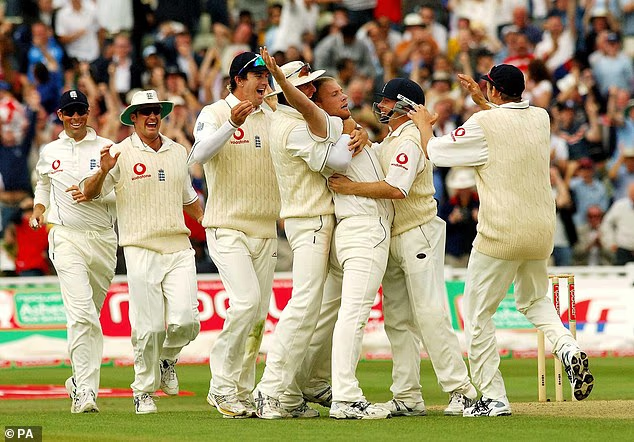
19. Andrew Flintoff: The Australians reckon Flintoff’s bowling in 2005 was as fast and as hostile as anything they ever faced
18. Geoffrey Boycott
34 Tests, 1964-81. Key stats: 2,579 runs at 46.05, six centuries.
Not everyone appreciated Boycott’s tempo. After scoring 63 not out on the first day at Perth in 1978-79, he received a note from Jack Birney, a local politician: ‘You have done for Australian cricket what the Boston Strangler did for door-to-door salesmen.’ A compliment, really.
Boycott scored seven meticulous hundreds against Australia including one in the non-Ashes series of 1980, the most famous of which came in 1977 after a self-imposed three-year exile.
His first innings back, after running out local hero Derek Randall, was 107 at Trent Bridge, and his third a glorious 191 in front of his adoring fans at Headingley.
That made him the first player in history to score his 100th first-class century in a Test match – the kind of stat he loved.

18. Geoffrey Boycott: Padding up in preparation for his 100th Test, at Lord’s in 1981. Boycott scored seven meticulous hundreds against Australia
17. Hedley Verity
18 Tests, 1932-38. Key stats: 59 wickets at 28.06, three five-fors.
An imperturbable left-arm spinner from Yorkshire, Verity dismissed Don Bradman eight times, more than any other Test bowler – most famously at Lord’s in 1934, when he removed him on successive days for 36 and 13.
His match figures of 15 for 104 – still England’s best there – led to their last Ashes win in St John’s Wood until 2009.
He played his part in the Bodyline win, too, taking five for 33 to round off the series at Sydney.
A captain in the Second World War, Verity died of his wounds in Italy in 1943 aged just 38, and his gravestone at Caserta, north of Naples, remains a poignant place of pilgrimage for cricket lovers.

17. Hedley Verity: An imperturbable left-arm spinner from Yorkshire, Verity dismissed Don Bradman eight times, more than any other Test bowler
16. Kevin Pietersen
27 Tests, 2005-14. Key stats: 2,158 runs at 44.95, four centuries.
Disguising a compliment as an insult, the Australians called Pietersen ‘FIGJAM’, which stood for ‘F*** I’m Good, Just Ask Me’.
And he really was good, depositing Glenn McGrath into the Lord’s pavilion on his Test debut in 2005, then securing the urn with a blistering counter-attack on the last day at the Oval, where his 158 had Vaughan hailing his ‘genius’.
Other examples followed: 158 and 227 on successive visits to Adelaide, and 113 at Old Trafford.
It ended messily, as Pietersen fell out with coach Andy Flower during the 2013-14 debacle, but by then he had figjammed his way into Ashes folklore.

16. Kevin Pietersen: His four centuries included back-to-back masterpieces at Adelaide, including a Test-best 227 in 2010 (pictured)
15. Bobby Peel
20 Tests, 1884-96. Key stats: 101 wickets at 16.98, five five-fors.
‘Mr Stoddart, gie me t’ball.’ With those words, Yorkshire left-arm spinner Bobby Peel let his captain know he was about to make history.
Australia had begun the sixth day at Sydney in 1894 on 113 for two, needing only 64 more runs for a 1–0 lead. The previous evening, fearing the inevitable, Peel and his team-mates had drowned their sorrows.
But heavy overnight rain had given way to morning sunshine, and in those days pitches remained uncovered: Peel knew a ‘sticky dog’ when he saw one.
Stoddart shuffed his man under the shower to sober up, then set him to work. Peel finished with six for 67 as the Australians folded to 166 all out, becoming the first team to lose a Test after enforcing the follow-on – and the only team to do so until Headingley ’81.
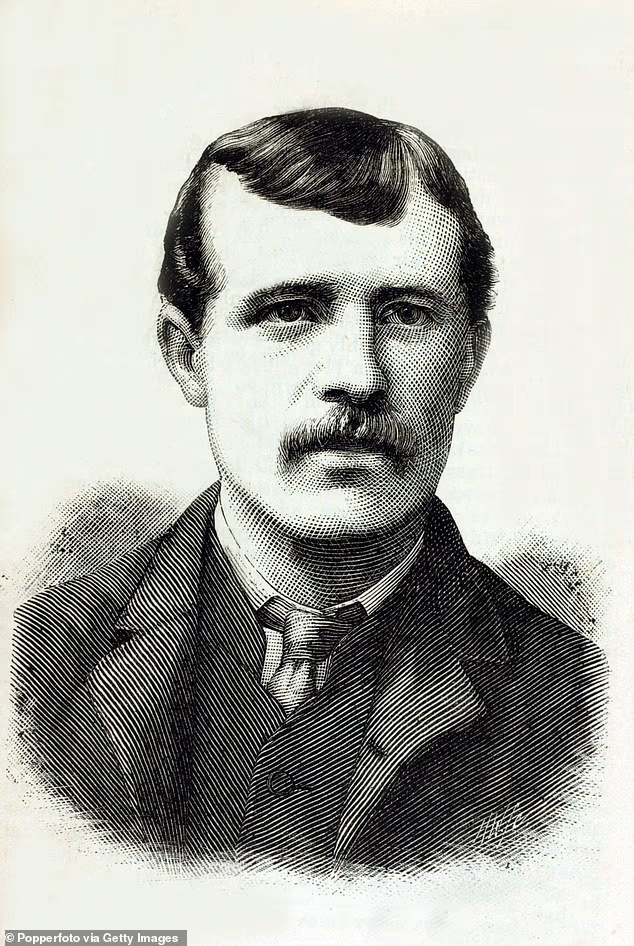
15. Bobby Peel: ‘Mr Stoddart, gie me t’ball.’ With those words at Sydney in 1894, Yorkshire left-arm spinner Peel let his captain know he was about to make history
14. Denis Compton
28 Tests, 1938-56. Key stats: 1,842 runs at 42.83, five centuries.
Michael Parkinson once observed that Compton was so chaotic he would arrive in a cloud of dust, even while walking with a stick. But, boy, he could bat.
In June 1938, having just turned 20, he marked his Ashes debut with a century at Trent Bridge. After the war, one of his first deeds was to score twin hundreds at Adelaide. A sparkling 184 followed, again in Nottingham, against Australia’s 1948 Invincibles, and – a month later – his masterpiece, an unbeaten 145 at Old Trafford after a blow on his (helmetless) head from Ray Lindwall.
Compton was a rare breed: an English cricketer popular with Australian fans, who would offer him beer over the boundary.
‘I think he limited himself to two a day at most,’ said his captain, Wally Hammond. ‘One in the morning and one in the afternoon.’
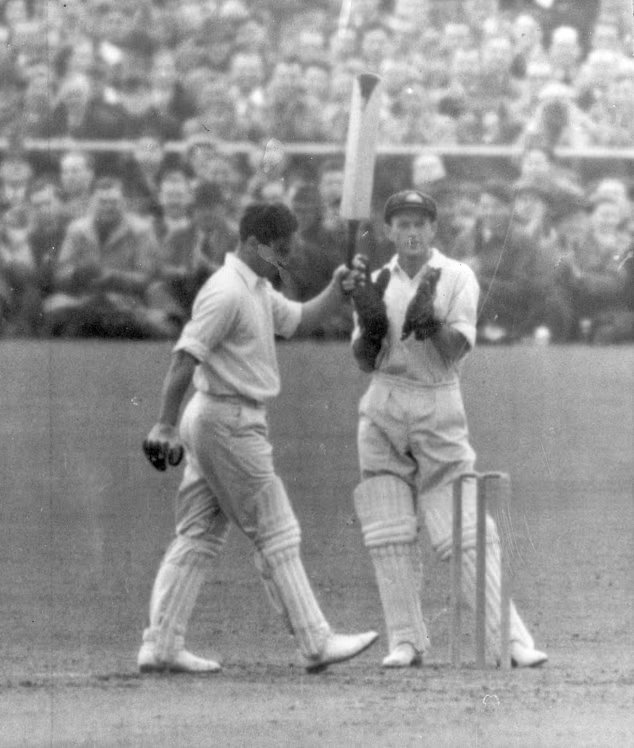
14. Denis Compton: Raising his bat in 1948 after reaching one of five centuries against Australia
13. Alec Bedser
21 Tests, 1946-54. Key stats: 104 wickets at 27.49, seven five-fors.
How good was Alec Bedser, the giant Surrey seamer who regarded line and length as a lifestyle choice?
Put it this way: he’s the only bowler to have dismissed Don Bradman for two Test ducks. And when Bedser removed him four times in succession during the 1948 series, Bradman shrugged: ‘You have to get out to someone, and who better than Bedser?’
Then there was the Australian opener Arthur Morris, whom Bedser dismissed 18 times. His zenith came at Trent Bridge in 1953, when match figures of 14 for 99 would almost certainly have led to victory but for rain.
When Bedser was dropped, for good, after one Test of the 1954-55 series, it caused a national outcry.

13: Alec Bedser: When he was dropped, for good, after one Test of the 1954-55 series, it caused a national outcry
12. Wilfred Rhodes
41 Tests, 1899-1926. Key stats: 109 wickets at 24.00, 1,706 runs at 31.01, one century, six five-fors.
To call Rhodes versatile did him scant justice.
A miserly slow left-armer who batted for England in every position from one to 11, he once put on 323 for the first wicket at Melbourne with Jack Hobbs, and at the age of 48 was recalled for the 1926 decider at the Oval, where his match figures of 45–24–79–6 were key to England’s 289-run win.
At the Oval 24 years earlier (after Gilbert Jessop’s record 76-ball hundred), he had walked out at No 11 with England needing 15. He was reportedly greeted by his fellow Yorkshire George Hirst with the legendary quip ‘we’ll get ’em in singles’, though neither man could recall the conversation.
Regardless, England won by one wicket.

12. Wilfred Rhodes: Standing furthest right, with Percy Chapman (second left) and Jack Hobbs (second right) inspecting the Oval pitch ahead of his recall at the age of 48 in 1926
11. David Gower
38 Tests, 1978-91. Key stats: 3,037 runs at 46.01, nine centuries.
Many years ago, I called Gower to ask for memories of his hundred at Adelaide in 1982-83. He replied: ‘What about my hundreds at Perth, Melbourne and Sydney?’
And it’s true: they were good too, because nothing he did with a bat could ever look bad.
Half of Gower’s 18 Test hundreds came against Australia, so only Jack Hobbs among Englishmen has more Ashes tons.
And Gower will always have 1985: three hundreds, including a double at Edgbaston, and the timeless image of him brandishing a replica of urn on the Oval balcony, blond curls, wry grin and all.
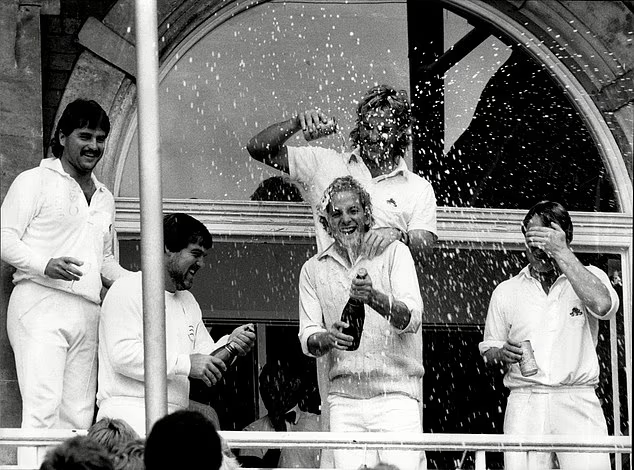
11. David Gower: Celebrating winning the sixth Ashes Test in 1985 at The Oval, with a helpful sprinkling from behind by Ian Botham
10. Jim Laker
15 Tests, 1948-59. Key stats: 79 wickets at 18.27, five five-fors.
Some Australians remain convinced that the greatest bowling feat in Test history – Laker’s 19 wickets at Old Trafford in 1956 – owed plenty to a doctored pitch, though that doesn’t explain why left-arm spinner Tony Lock managed only one wicket at the other end.
Nor was it a freak: two months before his Manchester miracle, Laker had taken 10 for 88 in the Australians’ first innings during a tour game against Surrey at The Oval.
Perhaps they just weren’t very good against off-spin.
Laker’s post-Test celebrations were perhaps the lowest-key in sporting history: breaking up the motorway drive back home, he stopped at pub for a drink and a sandwich, and sat unnoticed by other customers while highlights of his feat played out on the TV screen in the corner.

10. Jim Laker: He achieved the greatest bowling feat in Test history with 19 wickets at Old Trafford in 1956
9. Stuart Broad
40 Tests, Key stats: 153 wickets at 28.96, 1,019 runs at 18.87
Broad has more wickets against Australia than any England bowler, his haul including – most famously – eight for 15 on the first morning in Nottingham in 2015.
But his Ashes role transcended wicket-taking and moved into the altogether more nebulous realm of agent provocateur.
He refused to walk at Trent Bridge in 2013, laughed in the face of the Gabba boo boys, declared the Covid Ashes of 2021-22 ‘a void series’, and signed off with the series-squaring wickets in 2023, having earlier switched the bails to magically trigger the dismissal of Marnus Labuschagne.
Even as a pundit, he’s playing a shot a ball.

9. Stuart Broad: The ultimate showman signed off with the series-squaring wickets in 2023, having earlier switched the bails to magically trigger the dismissal of Marnus Labuschagne
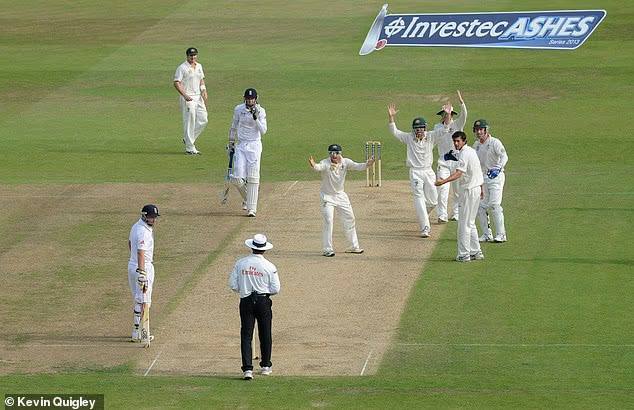
Refusing to walk at Trent Bridge in 2013 having nicked Ashton Agar to Michael Clarke at slip, via the gloves of Brad Haddin
8. Harold Larwood
15 Tests, 1926-33. Key stats: 64 wickets at 29.87, three five-fors.
It was Larwood’s spell to Bradman at The Oval in 1930 that sowed the seed.
He finished with one for 132, Bradman made 232 and Australia won by an innings, yet it was enough to persuade Douglas Jardine that the Don didn’t like it up him. ‘I’ve got it!’ he exclaimed when rewatching footage. ‘He’s yellow!’
On merciless Australian pitches in 1932-33, Larwood steamed in to take 33 wickets at 19, his run-up recalling ‘the Flying Scotsman thundering through an east coast station’, according to Aussie opener Jack Fingleton.
Not until Bradman fell for the final time in the series would Jardine allow an exhausted Larwood to leave the field, the two men walking off side by side in silence.

8. Harold Larwood: Australia captain Bill Woodfull ducks to avoid a steepling Larwood bouncer at Brisbane on the Bodyline tour in 1933
7. SF Barnes
20 Tests, 1901-12. Key stats: 106 wickets at 21.58, 12 five-fors.
Many good judges believe that Sydney Barnes, who bowled fast cutters and regarded himself as a spinner not a seamer, was the greatest bowler who ever lived.
And, until Broad ran rampant at Trent Bridge more than a century later, Barnes bowled arguably the most famous opening spell in any Ashes Test: 11–7–6–5 at Melbourne in 1911-12, setting up an eight-wicket win.
He wasn’t always popular with team-mates. When the boat to Australia for the 1901-02 tour hit a storm, England captain Archie MacLaren supposedly muttered: ‘If we go down, at least that bugger Barnes will go down with us.’
But he was one hell of a bowler, his general view being that if the batsmen weren’t nicking him, it was because they ‘weren’t playing well enough to get out’.
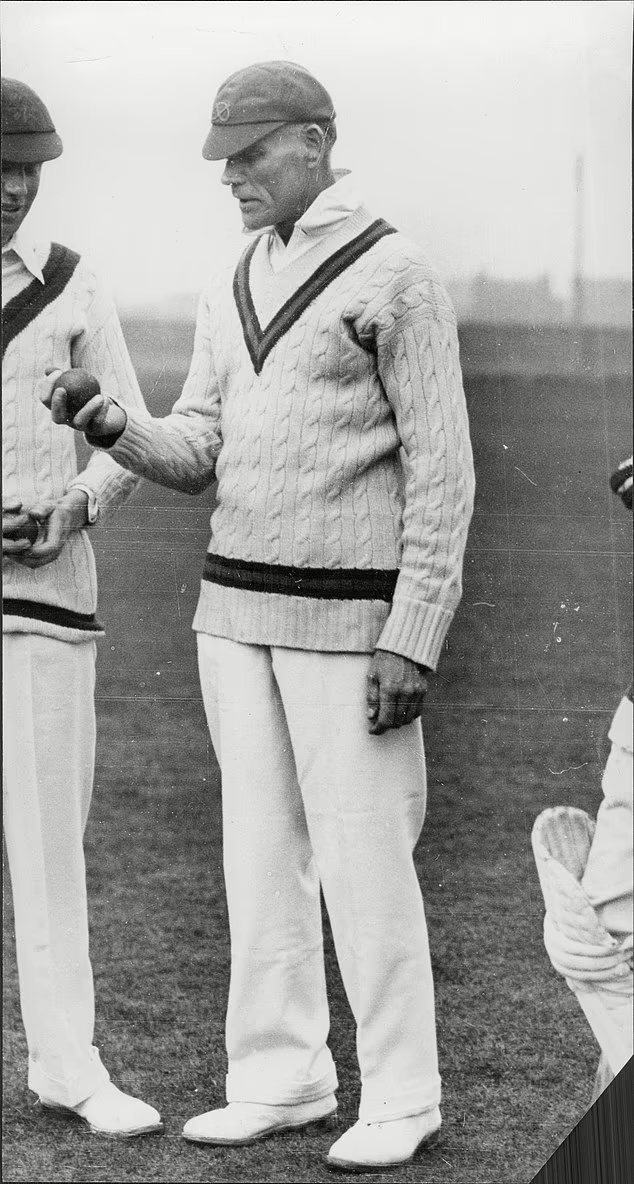
7. Sydney Barnes: Many good judges believe that Barnes, who bowled fast cutters and regarded himself as a spinner not a seamer, was the greatest bowler who ever lived
6. Walter Hammond
33 Tests, 1928-47. Key stats: 2,852 runs at 51.85, 36 wickets at 44.77, nine centuries, one five-for.
Hammond laid down his Ashes marker early, scoring 905 runs at 113 with four hundreds during Percy Chapman’s triumphant tour of 1928-29. No England player has ever managed more in a Test series.
And he barely paused for breath: 35 innings in Australia brought him an average of nearly 62, and only Bradman’s ascent robbed Hammond of the title of ‘world’s best batsman’.
His cover drive was to die for, and he had the greed of all the greats. Team-mate Charlie Barnett reckoned: ‘If I was lucky, I had an average of two balls an over to make my runs.’

6. Walter Hammond: His cover drive was to die for, and he had the greed of all the greats
5. George Lohmann
15 Tests, 1886-96. Key stats: 77 wickets at 13.01, five five-fors.
Of the six eight-wicket hauls taken by England bowlers in Australia, Lohmann has two. Even more impressively, they are the two best: eight for 35 at Sydney in 1887, eight for 58 at the same venue five years later.
He bowled medium-pacers, moving the ball both ways and allying supernatural accuracy (his Test economy-rate was 1.88) with clever experimentation.
If anything, he was not quite at his best against Australia: his overall bowling average was an absurd 10.75.
Tuberculosis eventually tamed him as no batsman could, but when Lohmann died at 36, his legend was long secure.

5. George Lohmann: Of the six eight-wicket hauls taken by England bowlers in Australia, Lohmann has two
4. Herbert Sutcliffe
27 Tests, 1924-34. Key stats: 2,741 runs at 66.85, eight centuries.
An urbane Yorkshireman, Sutcliffe played in six Ashes series between 1924 and 1934, and averaged at least 50 each time.
In the first, he had three innings in the two Tests at Melbourne, and scored 176, 127 and 143.
No English cricketer who played more than seven Ashes Tests averaged more than his 66.85. A hall of famer, then, by any standards.
The great Australian leg-spinner Bill O’Reilly summed him up: ‘Sutcliffe was the toughest competitor I ever faced in a Test match… it was an exquisite feeling to get one past his defensive bat.’
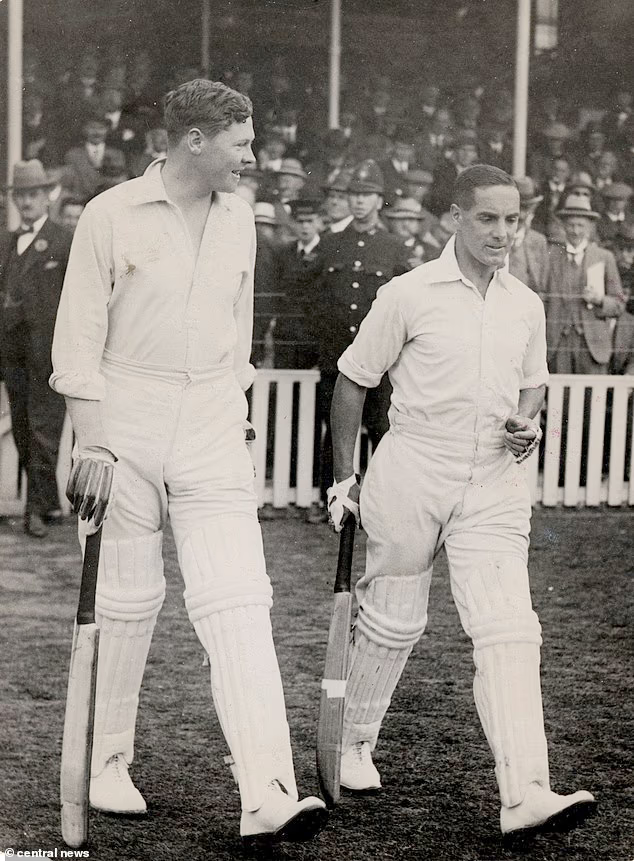
4. Herbert Sutcliffe: Pictured walking out to bat (right) with Percy Chapman, no man who played more than seven Ashes Tests averaged more than his 66.85
3. Len Hutton
27 Tests, 1938-55. Key stats: 2,428 at 56.46, five centuries.
Hutton began his Ashes career, aged 21, with a round 100 at Trent Bridge in 1938, and two months later compiled 364 – a Test record that stood for 20 years – at The Oval.
The Second World War robbed him of several years, and his left arm of two inches, thanks to an accident in the gym during commando training.
But he re-emerged as insatiable as ever, taking his place in the pantheon when he presided over a 3–1 win in Australia in 1954-55, one of only five series victories for England down under since the war.
His dry humour did not always chime with the locals. Spotting some of the struggling Australians having a coffee before the fifth Test of that trip, he offered them an hour’s free coaching.
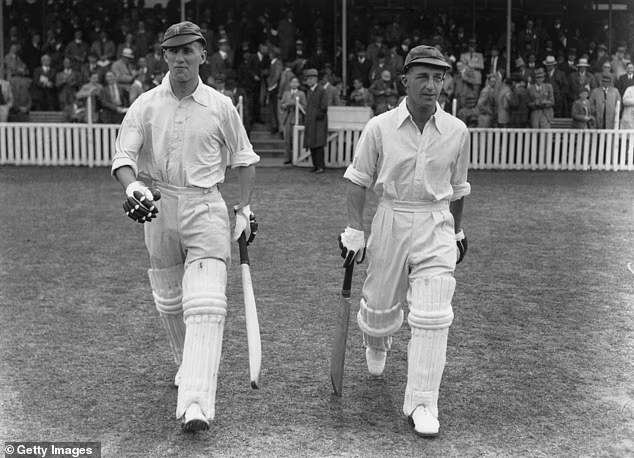
3. Len Hutton: Striding out to bat alongside Bill Edrich (left) at the Oval in 1938. Hutton scored a world-record 364
2. Jack Hobbs
41 Tests, 1908-30. 3,636 runs at 54.26, 12 centuries.
Hobbs can justifiably claim to be England’s greatest Ashes batsman: he has the most runs, the most centuries (12, including five at Melbourne alone), and took part in two 4–1 wins in Australia, in 1911-12 and 1928-29.
He was also at the heart of England’s emotional victory in 1926, when Australia were beaten for the first time since the First World War. Only Colin Cowdrey, with 43, can top Hobbs’ 41 Tests against the Aussies.
And he was always unfailingly modest, slipping away from the jubilant masses at The Oval with his wife via the Vauxhall entrance, where a friend was waiting with a car: ‘Thus we got quietly away from one of the most wonderful scenes that the world of cricket has ever known.’

2. Jack Hobbs: Hobbs (centre) bolts for the pavilion at the Oval in 1926 after England beat Australia by 289 runs to win the five-Test series 1-0

1. Ian Botham: The 1981 Ashes alone would have earned Botham his place. But there was much else besides

Underlying it all was the curious sense that Botham genuinely disliked his opponents
1. Ian Botham
1,486 runs at 29.13, 128 wickets at 27.65, three centuries, seven five-fors.
The 1981 Ashes alone would have earned Botham his place: a six-for, a fifty and 149 not out at Headingley, five for 11 at Edgbaston to pinch another cliffhanger, 118 at Old Trafford and 10 wickets at The Oval.
But there was much else besides: five-fors in each of his first two Ashes Tests, 11 wickets at the WACA, and a roistering century at Brisbane in the first Test of Mike Gatting’s victorious 1986-87 tour, when he took Merv Hughes and Co to the cleaners.
Underlying it all was the curious sense that Botham genuinely disliked his opponents.
Needless to say, he was later appointed the UK’s trade envoy to Australia on his elevation to the House of Lords.
